Photos by Roberto Motta and Automobilismo Storico Alfa Romeo, Centro Documentazione (Arese, Milano)

Roberto Motta has already presented the story of the first Alfa Romeo T33 (1967, chassis 75033.001 ) in a previous article. Here he inspects the last of the breed, the Turbo 33 as raced for the last time in Hockeneim on October 9th 1977.
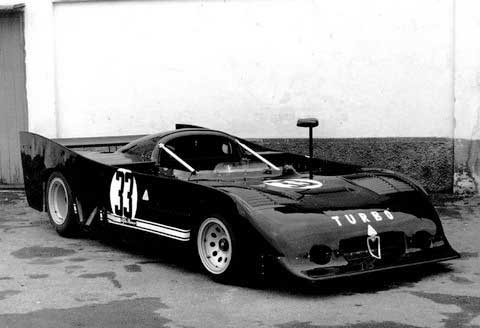
Factory photo of the turbo prototype.
Alfa’s Tipo 33 enjoyed a long and often glorious history, beginning with an inauspicious start in 1967, to the end of days in late 1977 when the victorious 33tt 12 Turbo (chassis 11512.016) was installed in the retirement community of the Alfa Romeo Automobilismo Storica at Arese.

The Turbo in its final resting spot, the Alfa Museum at Arese.
The T33 participated in over 230 events in its ten years on the track, and won 62. In actuality, the Tipo 33 was a variety of models, with different chassis, bodies and engines which reflected constant development and changing regulations.
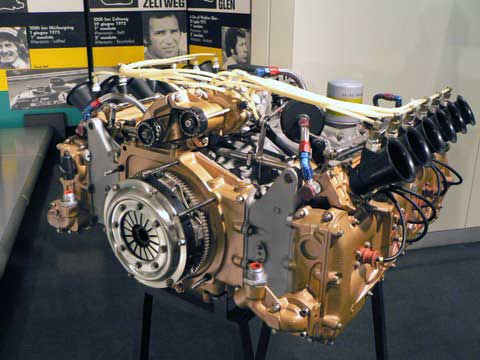
The normally aspirated version for the flat 12 at the Alfa Museum.
When in September 1972 the Alfa Romeo introduced a new 33 tt 12 (tt = Telaio Tubulare or Tubular Chassis), the car was powered by a new, normally-aspirated 3 liter flat 12 engine, which was able to push out over 500 bhp. This was necessary step, as the V8 was only able to produced 435 hp and no longer competitive, particularly in light of the latest Ferrari 312 PB, which was capable of 440 hp. It was assumed that the new engine would easily fit into the existing 33 tt chassis which had previously harbored the V8, but later it was found that the extreme torque and power of the flat 12 actually twisted the tubular frame.
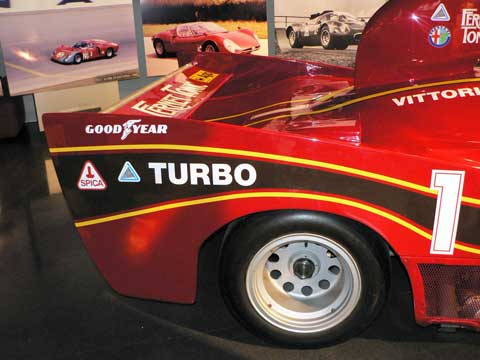
At the rear, 14.5 x15″ wheels got the power to the ground.
It was a long gestation period for the new flat 12, often branded as “mythical†by a skeptical press. When it finally made its appearance at Spa in 1973, the new car suffered a tire failure and crashed. Two new flat 12s were taken to the Targa Florio event, and two were crashed. 1973 was not a good season for the 33tt 12 and it won no races.
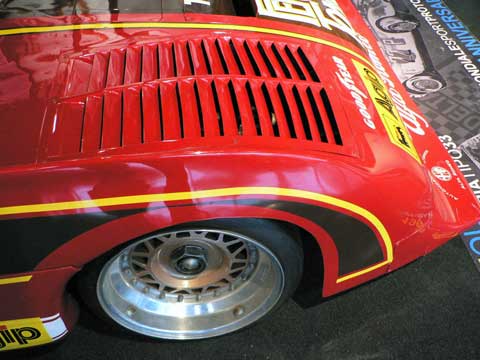
11 x 13″ wheels at the front of the tt33SC.
The 33 tt 12 won its first race at Monza on April 24, 1974, driven by Merzario and Mario Andretti. Still, success did not come with each race. Finally, Autodelta’s constant work paid off, for in 1975, the 33 tt 12 dominated the World Championship, with seven victories in eight championship races, even though by that time Alfa Romeo management focused its attention on the Formula 1 engine.
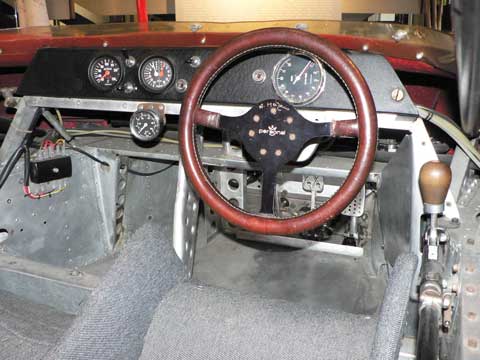
Steering wheel is signed by Arturo Merzario.
During the 1976 season, the Alfa Romeo technicians constructed a new car with a new monocoque chassis dubbed the 33 SC 12 (SC= Scatolato or monocoque) as the tubular chassis was not able to harness the power of the flat 12 which was now able to push out 520 bhp. In 1977, this wonderful car started in pole position and won every race it entered.
But Alfa management wanted even more, so the next stage of the long life of the T33 would involve the development of a flat 12, 2134 cc engine with twin turbochargers. This was being tested in 1976 at the same time the 33 SC 12 was being constructed.
The turbo engine had bore and stroke of 77 mm x 38.2 mm, and the total displacement was 2134 cc (130.2 cu in). Twin overhead camshafts with four valves per cylinder were gear driven. The fuel supply was by Lucas indirect injection and electronic ignition was by Magneti Marelli ‘Dinoplex’. The twin turbos were the KKK (Type Grosse K26), with two intercoolers. Needless to say, this resulted in a massive power increase; the Alfa Romeo flat 12 turbo engine was rated at 640 bhp at 11000 rpm, and pushed the car to the top speed of 352 km/h (217 mph).
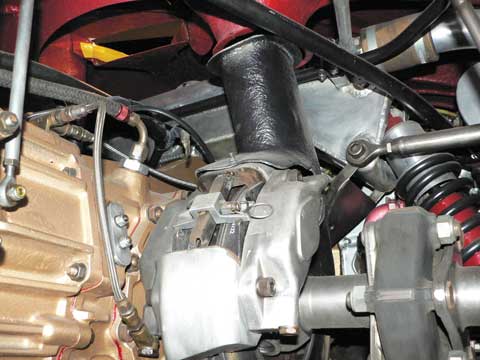
Inboard disc brakes at the rear with dual pistons.
A manual five speed transmission with a triple disc clutch and mechanical limited-slip differential were hung from the rear of the engine which also had additional lubrication with oil pump and radiator. The use of a rigid monocoque chassis was now the order of the day. The front suspension used a double wishbones, transverse arms, coil springs, telescopic shock absorbers, anti-roll bar, and the rear suspension used double wishbones, transverse arms, longitudinal beam, coil springs, telescopic shock absorbers and anti-roll bar.
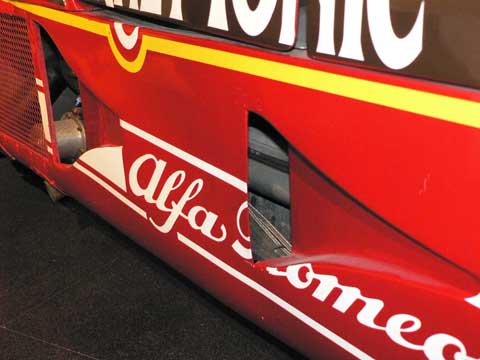
The car used four ventilated disc brakes, with double-piston brake calipers. The front discs are mounted at the wheels and the rear are mounted inboard near the differential.
The wheels of the 33/2 are in magnesium and the front has measure of 11 x 13″ and the rear 14.5 x15″. The front tire measure are 9.50/20/13″ and the rear 13.1/26.0/x15″.
The car declared a weight of 770 kg (1697.6 lbs), a wheelbase of 2500 mm, overall width of 2000 mm, overall length 3800 mm, front wide track of 1490 mm and rear wide track 1470 mm.
The turbo-engined 33 SC entered only two races; the 300 km Salzburgring and the Interserie Hockenheim. On September 18th, on the Salzburg ring , the turbocharged SC12 (chassis 11512.016) was driven by Arturo Merzario and finished at second place. During the race the car had some brake problem and on the wet trak was, Merzario says ‘â€it was very difficult to drive it“. On October 9th the Alfa Romeo T33/SC/12 Turbo entered and won the Interserie Hockeneim, with Merzario driving.
This was the last race for the Alfa Romeo prototype. The management then decided to concentrate its attentions on a new F1 car. Today it is possible to see this wonderful car, at the Alfa Romeo Museum in Arese.
Peter I love all your stories, great!
now about the Peugeot disc, & what do you think of my pictures? perhaps I want to sell them, thanks for letting me know
Thanks
I would like to know the history of my 1958 Alfa Giulietta Spider Veloce. Do you have the phone number, web site, or address to make an inquiry of centro documentazione Alfa Romeo?
Dear Sirs : I have an Alfa romeo 33 Q4 year 1993 (4×4) , all original and runing. Do you have some history about this beautiful car ? Thank you very much.